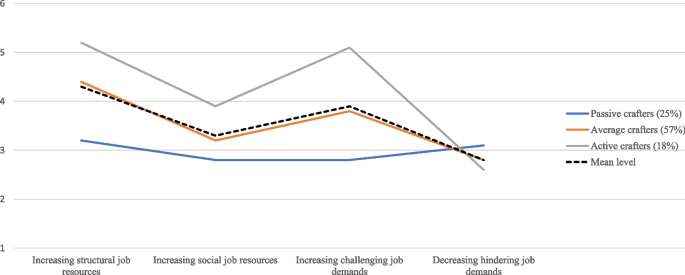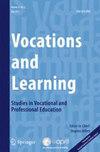How Do Job Crafting Profiles Manifest Employees’ Work Engagement, Workaholism, and Epistemic Approach?
IF 1.8
2区 教育学
Q2 EDUCATION & EDUCATIONAL RESEARCH
引用次数: 0
Abstract
Abstract The present study identifies job crafting profiles of public sector employees and how they differ in terms of employees’ work engagement, workaholism, and approach to learning. Participants represent various occupations from educational field (e.g., teachers), technical field (e.g., ICT-experts), and administrative field (e.g., customer servants). Using latent profile analysis, three job crafting profiles could be identified: Passive crafters (25%), Average crafters (57%), and Active crafters (18%). Passive crafters reported the lowest values in all approach-oriented job crafting strategies (increasing job resources and demands) and the highest value in avoidance-oriented job crafting (decreasing hindering job demands). Active crafters reached the highest values in all approach-oriented job crafting and the lowest value in avoidance-oriented job crafting. Average crafters used all job crafting strategies close to the average level. The lowest work engagement, workaholism, and reflective-collaborative approach to learning were reported by passive crafters. Both average crafters and active crafters reported higher workaholism and reflective-collaborative learning approach than passive crafters. Active crafters reported the highest work engagement. Study findings show the interplay between employees’ job crafting, work engagement, workaholism, and epistemic approach. This study extends workplace learning research field by offering new theoretical information and is the first one exploring job crafting profiles and their differences regarding employees’ epistemic approach; reflective learning, collaborative knowledge-building, and metacognition. Study discusses theoretical contributions and practical implementations, which may be used in work life induction, and in fostering job crafting and continuous workplace learning.

工作制作档案如何显示员工的工作投入、工作狂和认知方法?
摘要:本研究确定了公共部门员工的工作制作概况,以及他们在员工的工作投入、工作狂和学习方法方面的差异。参与者代表了教育领域(如教师)、技术领域(如信息通信技术专家)和行政领域(如客户服务人员)的各种职业。使用潜在特征分析,可以确定三种工作制作特征:被动工匠(25%),平均工匠(57%)和主动工匠(18%)。被动式工匠在所有方法导向的工作制作策略(增加工作资源和需求)中价值最低,在回避导向的工作制作策略(减少阻碍性工作需求)中价值最高。主动型工匠在所有面向方法的工作制作中得分最高,在面向回避的工作制作中得分最低。一般工匠使用的所有工作制作策略都接近平均水平。被动手艺人的工作投入、工作狂和反思性合作学习方式最低。与被动工匠相比,普通工匠和主动工匠报告了更高的工作狂和反思性合作学习方法。活跃的工匠报告了最高的工作投入。研究结果表明,员工的工作构思、工作投入、工作狂和认知方法之间存在相互作用。本研究拓展了工作场所学习的研究领域,提供了新的理论信息,并首次探讨了工作塑造概况及其在员工认知方法上的差异;反思性学习、协作性知识构建和元认知。本研究讨论了理论贡献和实际实施,可用于工作生活归纳,并在促进工作制作和持续的工作场所学习。
本文章由计算机程序翻译,如有差异,请以英文原文为准。
求助全文
约1分钟内获得全文
求助全文
来源期刊

Vocations and Learning
EDUCATION & EDUCATIONAL RESEARCH-
CiteScore
5.30
自引率
17.90%
发文量
21
期刊介绍:
Vocations and Learning: Studies in Vocational and Professional Education is an international peer-reviewed journal that provides a forum for strongly conceptual and carefully prepared manuscripts that inform the broad field of vocational learning. The scope of the journal and its focus on vocational learning is inclusive of vocational and professional learning albeit through the very diverse range of settings (e.g. vocational colleges, schools, universities, workplaces, domestic environments, voluntary bodies etc) in which it occurs. It stands to be the only truly international journal that focuses on vocational learning, as encompassing the activities that comprise vocational education and professional education in their diverse forms internationally. Vocations and Learning aims to: enhance the contribution of research and scholarship to vocational and professional education policy; support the development of conceptualisation(s) of vocational and professional learning and education; improve the quality of practice within vocational and professional learning and education; and enhance and support the standing of these fields as a sectors with its own significant purposes, pedagogies and curriculums. Vocations and Learning: Studies in Vocational and Professional Education encourages the submission of high-quality contributions from a broad range of disciplines, as well as those that cross disciplinary boundaries, in addressing issues associated with vocational and professional education. It is intended that contributions will represent those from major disciplines (i.e. psychology, philosophy, sociology, anthropology, history, cultural studies, labour studies, industrial relations and economics) as cross overs within and hybrids with and amongst these disciplinary traditions. These contributions can comprise papers that provide either empirically-based accounts, discussions of theoretical perspectives or reviews of literature about vocational learning. In addition, books, reports and policies associated with vocational learning will also be reviewed. Topics addressed through contributions within the proposed journal might include, but will not be restricted to: curriculum and pedagogy practices for vocational learning the role and nature of knowledge in vocational learning the nature of vocations, professional practice and learning the relationship between context and learning in vocational settings the nature and role of vocational education the nature of goals for vocational learning different manifestations and comparative analyses of vocational education, their purposes and formation organisational pedagogics transformations in vocational learning and education over time and space analyses of instructional practice within vocational learning and education analyses of vocational learning and education policies international comparisons of vocational learning and education critical appraisal of contemporary policies, practices and initiatives studies of teaching and learning in vocational education approaches to vocational learning in non-work settings and in unpaid work learning throughout working lives relationships between vocational learning and economic imperatives and conceptions and national and trans-national agencies and their policies.
 求助内容:
求助内容: 应助结果提醒方式:
应助结果提醒方式:


